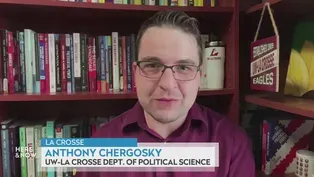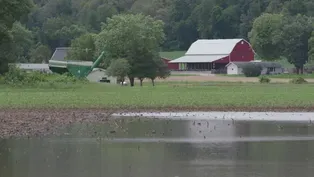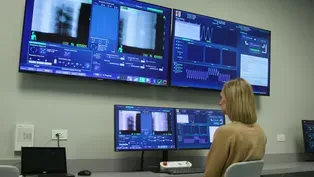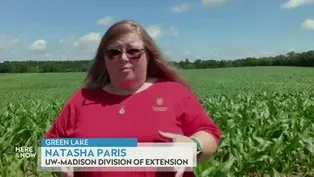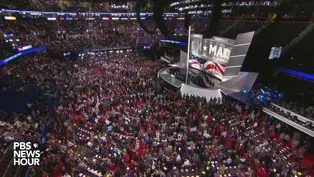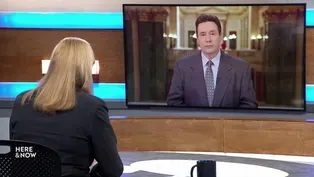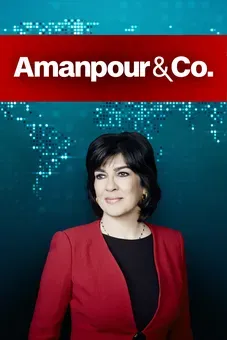Here and Now
Here & Now for July 5, 2024
Season 2300 Episode 2301 | 26m 48sVideo has Closed Captions
Watch the entire episode of Here & Now for July 5, 2024.
Watch the entire episode of Here & Now for July 5, 2024.
Problems with Closed Captions? Closed Captioning Feedback
Problems with Closed Captions? Closed Captioning Feedback
Here and Now is a local public television program presented by PBS Wisconsin
Here and Now
Here & Now for July 5, 2024
Season 2300 Episode 2301 | 26m 48sVideo has Closed Captions
Watch the entire episode of Here & Now for July 5, 2024.
Problems with Closed Captions? Closed Captioning Feedback
How to Watch Here and Now
Here and Now is available to stream on pbs.org and the free PBS App, available on iPhone, Apple TV, Android TV, Android smartphones, Amazon Fire TV, Amazon Fire Tablet, Roku, Samsung Smart TV, and Vizio.
Providing Support for PBS.org
Learn Moreabout PBS online sponsorshipWisconsin Original production.
>> You're watching "Here& Now" 2024 election coverage was terminated following a leak out of the Wisconsin Supreme Court.
An official order shows the state's highest court will take up abortion rights.
Wisconsin is poised to receive millions to expand biotechnology and from drought to deluge, experts mark two historic years of weather.
I'm Frederica Freyberg tonight on "Here& Now" we'll hear updates on the cases at the Wisconsin Supreme Court.
Then a preview of the state's political landscape under new voting maps.
More on how Wisconsin is butting into a biotech nerve center, and how weather whiplash is impacting farmers.
It's "Here& Now" for July five.
>> Funding for "Here& Now" is provided by the Focus Fund for Journalism and Friends of PBS.
Wisconsin.
Court opinions were released this week, and an order to hear a lawsuit brought by planned Parenthood of Wisconsin asking the court to rule that access to abortion is protected by the state constitution.
The court also decided to take up the appeal to a Dane County judge's ruling that declared Wisconsin does not have an abortion statute, only one that outlaws attacking a woman in an attempt to kill her unborn baby.
Senior political reporter Zac Schultz joins us from the Capitol with more on.
Hi, Zach.
Hello, Fred.
With liberal justices in the majority, how fast tracked and foregone are these abortion cases expected to be?
>> Well, we've already heard from the conservatives through their dissents to taking these cases that they fully expect the majority on this court to decide in favor of abortion rights and strike down this 1849 law, and perhaps even go as far as to enshrine the right to abortion in the Wisconsin Constitution.
So I think everyone expects that to be the end result in this process.
It would actually be quite surprising to conservatives and a lot of the liberals that supported Janet Protasiewicz in her run for the court just last year, if they didn't go that route.
>> So how soon could a decision in these cases come?
>> Well, we've got a briefing schedule right now, 40 days and 20 days for responses.
That puts us into the fall.
So you can expect oral arguments to be scheduled sometime in either September or early October.
That puts us on track for a decision either by definitely before the even around the election, depending on where this lands.
This could come right before November.
>> Reading the writings in this order.
The vitriol in this court persists.
>> Absolutely.
The dissents are acting as press releases for both sides of the concurrences and the dissents.
They're responding to each other in the footnotes.
This isn't new, but it's become more outspoken.
Justices don't do a lot of interviews.
They don't really come on our program that often unless they're running for reelection, as you know, Fred, and they don't sit for a lot of interviews.
But this is their way of promoting their views to their specific audiences.
And we know the courts become politicized, and there are political audiences wanting to favor of these decisions.
>> So but but before decisions in these cases, there are decisions and two other big cases, one involving the legality of absentee ballot drop boxes.
revisiting the Teigen case that outlawed ballot drop boxes.
That came a couple of years ago.
In that case, that was when the conservatives controlled the court.
It was a very fractured decision.
Justice Hagedorn made the deciding vote, and he only concurred with a handful of paragraphs, basically only enough to say ballot drop boxes are not specifically allowed by law and therefore are not allowed under the Constitution.
Now, the liberals on the court decided to retake that case under a few new angles.
And it's also, again from the conservatives and their dissent, saying we fully expect the liberals to approve ballot drop boxes.
But no matter what, there will be some certainty as this case comes out and the decision is rendered for clerks to know what to expect from August through November, so people know whether they can put their ballots in the mail or to drop box, and how to vote.
This fall.
>> And then there was the case over separation of powers, where legislative committee vetoes shut down the governor's stewardship, land purchases.
>> That's right.
Governor Evers sued over a number of different things that the Joint Finance Committee has held up.
These were appropriations spending that were approved in a bill that were signed into law by the governor, fully approved.
But then the funding could only be released at a later date by the Joint Finance Committee.
And it was held up by Republicans in a number of different cases.
Now, the governor sued, and the Supreme Court is only taking this on stewardship, which is land purchases that are designed to be for the benefit of all, for public property, for outdoor natural resources, hunting, skiing, fishing, etc.
they're going to rule on those specific cases.
But it could have much broader ramifications because going on over PFAS funding being held up under joint finance.
In the same manner, we've got funding for the hospitals up in northwest Wisconsin being held up.
So depending on how broad that ruling is, it could impact a lot of other areas besides stewardship.
>> So is that the reason that they could kind of just choose stewardship specifically because potentially the implications are much broader.
>> Well, it this depends.
Courts in the past will take a very narrow approach to some things and rule only on the one issue before them, or they've seen other times where they take one narrow issue and then they broaden it out and it applies to a lot of other places.
And we'll just have to see how broad this is.
And we may not know until court rulings down the road all right.
be following these.
Of course.
Zac Schultz.
Thank you.
Thank you.
How do down ballot candidates like those running for U.S. Senate in Wisconsin, fare with the tumult at the top of the Democratic ticket for president on this in the state of legislative races, we turn to UW La Crosse political scientist Anthony Chergosky.
And being here.
Thank you.
So obviously, things are shaky at the top of the ticket.
Now, more than a week out from Joe Biden's very bad debate performance.
What effect might this have on Wisconsin's U.S. Senate race and its candidates?
>> I think the effects could be substantial, Fred, and that is because the amount of split ticket voting has gone down over the years by split ticket voting, I mean a ballot where a voter votes for at least one Democrat and one Republican on the same ballot.
More and more, we're seeing voters vote straight ticket, meaning they vote for the same political party for all of the races on the ballot.
As Partizanship in the electorate has increased, and as the political divide in society has widened, we see more and more that how someone votes for president is a great predictor of how they vote in other races on the ballot.
So what happens at the top of the ticket will really matter when it comes to explaining what happens down the ballot.
>> So how does Joe Biden dropping out change the calculus for other races?
>> I think other candidates need to adjust to the new political realities because they could try to perhaps distance themselves from the presidential campaign, try to run their own race.
As Senator Baldwin said in a recent statement, it is still possible nowadays to get some cross party voters, but it takes a strong candidate with the right message and the right amount of resources to pull that off.
It's not easy to get voters to cross the party line, but it can be done in certain circumstances.
And in fact, with Senator Baldwin, we've seen that in the past.
She has been able to pull in at least some voters who tend to go the Republican direction.
>> Similar effects down to congressional races and even state legislative races.
>> I would say.
So what happens at the presidential level will affect Democrats chances of unseating Republican incumbents House of Representatives races.
Democrats have talked up their opportunities to defeat Bryan Steil and Derrick Van Orden.
And what happens at the presidential level will affect their chances of doing that.
And of course, when we look at the state Senate and state Assembly, Democrats are enthusiastic about the new district maps.
But how much can they take advantage of those new district maps?
What happens at the in the other races on the ballot will have a lot to say about that.
>> So as to the legislature, between, as you say, these redrawn districts and retirements, nearly two thirds of the Assembly seats are open this election, 60 open seats of 99, and Dems have 120 candidates running.
How stunning is that?
>> A candidate recruitment was going to be huge this time around because there are so many redrawn districts, so many districts that have changed significantly since the last round of redistricting.
So the pressure is going to be on these candidates to introduce themselves to the voters.
We see a lot of incumbents who are either not running or are running in a very different district.
A lot of new faces coming into the political scene for these state legislative races.
So the stakes are high and these candidates are going to have to work really hard.
They're going to have to knock on a lot of doors, march in a lot of parades, make a lot of phone calls to be successful in this campaign.
>> So you remarked how candidate quality would affect the battle for majority control of the Assembly.
Is that what you mean?
Does these people have to really get out there, put their faces out there and be super engaged?
>> Absolutely.
The right messag, the right candidate with the right amount of resources, a candidate who can quickly develop trust in what might be a redrawn district or might be a completely new district, a candidate with a compelling message that can take advantage of the political conditions on the ground.
Maybe they need to distinguish themselves from the other candidates of their party on the ticket.
And of course, money, money, money that's going to play a huge role in candidates being able to get their message out in a very crowded political environment.
It's going to be tough for these state legislative candidates to break through in a climate where we've got a high profile presidential race, high profile U.S. Senate race, these state legislative candidates are going to have to work hard.
>> So how likely is it that Democrats could win control of the Assembly?
>> It's quite possible.
And they need to also have a good showing in the state Senate races to lay the groundwork for 2026, where they hope to make a run at the majority.
Right now, I would tend to believe that the Republicans are the favorite for the state Assembly majority, but there is some uncertainty about that.
And for over a decade, it's been darn certain that Republicans would be the majority party.
For the first time in a long time.
There's at least some question about which party will hold majority control in the state Assembly when we see the new Assembly members come in to office next January.
>> All right.
We leave it there.
Professor Anthony Chergosky, thanks very much.
>> Thank you.
>> The Republican National Convention is less than two weeks away, and the Democratic convention is coming in late August.
Each will bring thousands of visitors and millions in revenue to Milwaukee and Chicago.
But what is a national convention and who gets to go "Here& Now" Reporter Aditi Debnath has more.
>> Two major Midwest cities are gearing up to host national political conventions this summer the Republican National Convention in Milwaukee and the Democratic National Convention in Chicago.
Republicans will meet in less than two weeks to select former President Donald Trump as their nominee for the presidential election.
Democrats would nominate President Joe Biden if he doesn't drop out of the race before the DNC in late August.
This is the main purpose of these conventions.
Officially selecting presidential nominees.
Delegates from each state attend the event on behalf of the Democratic or Republican voters in their state.
Delegates can be party officials that represent the state, like Wisconsin's Republican Party Chair Brian Schimming or Democratic Party Chair Ben Wikler.
They can also be district delegates that represent voters in one of Wisconsin's eight congressional districts.
Almost 2500 delegates will visit Milwaukee in July, 41 of which are from Wisconsin.
The DNC is larger and Wisconsin will send 95 out of 4600 delegates.
The conventions are not just a place for presidential nominees to win over voters watching at home.
Up and coming political figures give speeches throughout the week, which can put them on the map for future partisan elections.
Conventions are also a place for parties to decide on their political platform moving forward.
Delegates and party members determine a party's platform by making policy recommendations, which often nominee's campaign proposals.
This aspect of the convention is crucial in giving party members space to disagree and resolve political conflict within the party.
In the 2020 presidential election, the GOP made no changes to their platform as former President Trump was running as an incumbent.
The Dems did update their platform that year, which included recommendations made by Bernie Sanders.
This included investing in climate change prevention and attempting to relieve student debt.
The unique partnership between Biden and Sanders helped Biden win Sanders supporters in the general election, which included many young voters.
This election yea.
Neither party's presumed nominee has a high profile opponent in the primary.
Viewers can watch the RNC and DNC live at home as the events are closed off to the public.
Both conventions are four days long.
The RNC begins July 15 and the DNC begins August 19.
For "Here& Now, I'm Aditi Debnath.
>> In medical news, Wisconsin learned this week it has been named as one of 12 technology hubs for the bio health industry, and with that designation comes nearly $50 million.
Over the next five years.
The focus is on personalized or precision Stephen Potter reports.
Wisconsin is front and center on efforts to advance precision medicine.
>> I love this machine.
>> A couple of years ago, when she was 43, Megan Haensgen had a doctor's appointment, went in and saw that colorectal surgeon.
>> He sat down, looked me square in the face and said, I'm almost 100% certain you have cancer.
And I argued.
I said, no, I'm here for my hemorrhoid.
And he gave me a minute.
And then I realized that he what he was saying.
And so that was the start of the journey.
They did a biopsy in the office that day.
Everything was very quick, rushed, definitely felt a sense of urgency.
I knew I'd been walking around with cancer for several years, so I was really scared.
cancer treatment could be done close to home, and they said no.
>> We feel strongly that this is where you need to be.
>> She had her treatment done at the Froedtert hospital campus in Milwaukee, using the Radixact Radiation therapy machine.
It's designed to deliver cancer killing beams of energy to a very focused area.
And given the sensitive spot of Haensgen cancer and the proximity to the rest of her digestive system, that's exactly what she needed.
>> As a patient.
You want as targeted of a therapy as you can get, so you don't damage healthy tissue, and so you can spare, you know, your quality of life, that kind of precision, tailor made treatment based on the individual patient's conditions, ailments and body needs is known as precision or personalized medicine.
>> And researchers say it's the wave of the medical future.
>> Every patient is a unique individual.
They have their own genetics, their own exposures, their the environment that they have been in.
And so precision medicine is this approach that could we actually learn more about each individual patient so that each patient gets the right drug at the right time?
>> Doctor Mohammad Murtaza is the associate director of the center for Human Genomics and Precision Medicine at component of precision medicine, he says, is looking at a patient's DNA.
Doctors like Murtaza work to explore how precision medicine can develop treatments for patients with ailments like asthma, COPD, kidney disease and of course, cancer.
of their therapy based on their genetic makeup?
So not just the makeup of their cancer, but actually their genetic makeup that they were born with, Murtaza says.
>> We've barely scratched the surface of what these new medical advancements can do.
>> What I see precision medicine interacting with a lot more is new advances in data science and artificial intelligence and us really make sense of this data and then make better clinical decisions.
>> But precision medicine isn't just research and patient treatment.
It's also big business.
A number of Wisconsin companies are poised to be the lead innovators in this medical revolution.
>> It's very precise, submillimeter accurate radiation.
called Accuray, which moved its headquarters to southern Wisconsin last year.
products the CyberKnife, the Radixact, which is also the form of TomoTherapy, which originated here in Wisconsin and then the precision planning software where the doctors pull in MRI and CT images and they literally paint on the image, where do they want to radiate?
And then the areas that they want to protect from radiation.
precision and personalized medicine companies operating in the state.
>> We have leaders in genomics, like exact Science for diagnostics, Illumina for DNA sequencing.
And then we have this a supply chain that's built around Plexus and Rockwell, where we actually manufacture and make things here.
And then we have the clinical institutions like UW, the Medical College of Wisconsin.
So within Wisconsin, we have the whole ecosystem of what we were calling the invent, build and deploy life cycle for personalized medicine.
>> Because of this network of companies, the federal government recently designated Wisconsin as a bio health technology hub, which may also mean an influx of money.
Lisa Johnson is the chief executive officer at BioForward, the state's bio health industry association.
She explains the objective behind the designation to fund tech hubs throughout the country in key technology areas where the United States needs to become more competitive.
The program also brings together partnerships for data collection with the intent to benefit patients.
>> That data collection that really guides now our physicians, but also certainly our innovators on where what kind of drugs should be brought to market.
It's certainly we get that data from medical imaging from our diagnostics to really guide where we should go with our drugs in the future.
>> Personalized medicine is about the right treatment for the right patient at the right time.
So the goal is to give them effective care, but also not to give them unnecessary care where they're going through unnecessary procedures, unnecessary tests.
It may be having side effects that that they don't need to face, but to really match them with what's going to address their disease.
>> For patients like Haensgen, who is now cancer free after chemotherapy and laser focused radiation, precision and personalized medicine made a life altering difference.
She hopes the advancements continue, even since the three years that I've been treated, I know that my doctors and my team at my hospital on this machine are doing things a little differently, and that's just in the last three years.
>> So I can only imagine that research and innovation just will improve going forward.
To make things even better for future cancer.
Cancer patients and future generations.
>> For "Here& Now, I'm Stephen Potter.
>> Turning to agriculture, experts are calling it a weather whiplash.
First, too much dry weather caused drought in Wisconsin.
Now there's too much rain for farmers and their crops are feeling the effects.
We turn to Natasha Perez, covering central Wisconsin as regional crops educator with UW-Madison extension, who joins us from Green Lake.
And thanks very much for being here.
>> Thanks for having me.
>> So describe the weather whiplash, as you call it.
How severe is it, >> well, last year at this time, we had just experienced our fourth driest May on record and our 10th, driest June on record, and we were still in drought here in Green Lake County into the end of May.
And now here in Green Lake, we aren't in drought anymore.
And in fact, we've had excess amounts of rain.
And, statewide we had the 10th wettest May on record.
And the numbers are still being finalized, but we're looking at being in the top ten wettest Junes as well.
>> So where in the state is the worst of the water access, >> it's really in that north central region, spanning kind of from the northeast over to the north central, there's, there's kind of this, this band, across, I think it's in marathon, Lincoln, Langlade area, that's, that's that's had an excess amount of rain.
And I've heard from folks up there that there really haven't been able to get a lot of their crops in, and there's a lot of fields that are just standing empty or the crops have failed.
Yeah, that was what I was going to ask is what has been the effect on crops?
Yeah So, we have we have fields where, the, the crops were able to get in early and, sometimes they've made it through and done and done pretty well.
But then sometimes they got caught in those absolute deluges of rain and they, they, they were drowned out.
So we've been talking about things like replant, or there's, there's cases where they've just never been able to get in the fields at all.
And so we're looking at, at what we call a prevented plant situation where you if you have the right crop insurance, you might be able to receive some type of payment.
But there's a lot of fields where, the corn was planted a month late, if not more.
>> So what are what are farmers telling you about their their mood with all of this right now, it really depends on the farm.
>> It depends on what they're growing for, I, you know, they're they're they're for the some of them are feeling are really feeling the pinch in terms of if they are a dairy farm and they planted a new seeding of alfalfa and they weren't able to get much out of it or the, the alfalfa that they have been able to harvest because it was delayed, because it was so wet, the quality isn't very good.
And so you're just not getting going to get as many pounds of milk out of that.
So that's really been putting a pinch on some of our dairy farmers.
notes manure runoff risk.
Is that an overall risk or more so in specific places in the state, >> well, it's a risk based on soil type and topography.
So areas where we have those, those, those, those clay soils, and the Filthier soils that are, that are going to move more easily, that can that can cause risk.
And then, obviously on areas where there's, there's more hills and then also the type of tillage and the type of cropping system being used.
And so there's been some rain events this year that have kind of overdone whatever cropping system has been in place, but so we've been really trying to, to help people use the tools that are available to assess the intensity of the rainfall that could be predicted, to better to time their manure applications, to, to prevent runoff.
>> So gauging what you're seeing to date, what does the rest of the growing season hold?
Well, we are we're looking at, a little bit warmer, a little bit, a little bit wetter.
>> July, but then over the course of the summer as a whole, we're looking at warmer.
There's not a clear signal yet.
About what?
About being wet or dry, and so at this point, those who have really had these early season struggles are hoping for some, some, break in the rain so that they can at least get established.
Maybe, maybe an alternative forage here in the in the, high summer to be able to grow some feed for the animals, and those who are growing for grain purposes are looking at, really dialing in their, their disease management because this hot, wet weather is going to really kick up the incidence of disease that we're having in, in our crops.
And so really making sure that we're timing those fungicide applications at the right time.
So we can counteract disease that can affect yield and quality.
Perez, thank you very much.
>> Thank you.
>> For more on this and other issues facing Wisconsin, visit our website at PBS Wisconsin.
Org and then click on the news tab to see all of our election coverage.
Visit Wisconsin tonight.
I'm Frederica Freyberg.
Have a good weekend.
>> Funding for Here and Now is provided by the Focus Fund for Journalism and Friends of PBS.
Anthony Chergosky on Down-Ballot Races in the 2024 Election
Video has Closed Captions
Anthony Chergosky on the 2024 presidential race affecting votes for the state Legislature. (5m 41s)
Here & Now opening for July 5, 2024
Video has Closed Captions
The introduction to the July 5, 2024 episode of Here & Now. (1m 10s)
How Wisconsin Is Creating the Future of Precision Medicine
Video has Closed Captions
Wisconsin's federal designation as a biohealth technology hub is generating high hopes. (6m 3s)
Natasha Paris on Wisconsin's Farms Facing Weather Whiplash
Video has Closed Captions
Natasha Paris on impacts of extreme weather conditions on Wisconsin's growing season. (5m 19s)
What's the Purpose of the RNC in Milwaukee, DNC in Chicago?
Video has Closed Captions
The RNC in Milwaukee, DNC in Chicago will command attention as the 2024 race intensifies. (2m 52s)
Zac Schultz on the Wisconsin Supreme Court and Abortion Law
Video has Closed Captions
Zac Schultz on the Wisconsin Supreme Court hearing cases on the legal status of abortion. (4m 58s)
Providing Support for PBS.org
Learn Moreabout PBS online sponsorshipHere and Now is a local public television program presented by PBS Wisconsin
